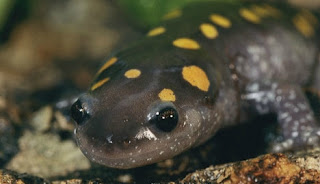Secretive and expert at hiding, spotted salamanders live in forests throughout much of the eastern United States and Canada. Though these bluish-black salamanders are large—about seven inches (18 centimeters) long—and distinctly marked with bright yellow or orange spots, they're still not easy to find. They're active only at night. During the day they stay quietly hidden under rocks, leaf debris, and logs. They also use other animals' burrows as their daytime hideouts. Spotted salamanders' favorite habitat is forests near rivers and streams. Salamanders are amphibians, like frogs and toads. Their lives are closely tied to water. The rains of springtime signal the time for spotted salamanders to migrate to their breeding ponds for egg-laying. Adults return to the same pool for breeding year after year, for their whole lives.
Salamanders choose ponds or temporary, seasonal pools for laying their eggs. The females lay their eggs in clusters of up to 200. They coat the cluster with a thick jellylike substance that holds all the eggs together, anchored to vegetation in the pool.
 It takes from 20 to 60 days for spotted salamander eggs to hatch. Like the tadpole stage of a frog, the salamander also starts out in a larval stage. It must be in water to survive until it develops into the adult salamander form, which takes from 60 to 90 days. Young salamanders eat the larvae of such insects as beetles and mosquitoes that share the water, as well as small animals they find around the edges of their pond. Spotted salamanders produce a nasty-tasting toxin in glands on their backs and tails. If a predator grabs them, the toxin quickly lets it know that the salamander is not a good meal.
It takes from 20 to 60 days for spotted salamander eggs to hatch. Like the tadpole stage of a frog, the salamander also starts out in a larval stage. It must be in water to survive until it develops into the adult salamander form, which takes from 60 to 90 days. Young salamanders eat the larvae of such insects as beetles and mosquitoes that share the water, as well as small animals they find around the edges of their pond. Spotted salamanders produce a nasty-tasting toxin in glands on their backs and tails. If a predator grabs them, the toxin quickly lets it know that the salamander is not a good meal.When it's the salamander looking for a tasty meal, it goes after such prey as insects, worms, slugs, spiders, and millipedes. Spotted salamanders are not considered endangered, but threats to their populations do exist. Salamanders are very sensitive to pollution and other changes in their environment. They are also vulnerable to habitat loss, caused by such human activities as logging. Spotted salamanders have also been put at risk by people who collect them to sell as pets.
 FAST FACTS
FAST FACTSThe scientific name of the spotted salamander is Ambystoma maculatum.
In the wild, the spotted salamander can live up to 20 years.
There are about 500 species of salamanders. On average, spotted salamanders grow to be seven inches (18 centimeters) long. Large individuals can reach nine inches (23 centimeters) long.
When a spotted salamander first hatches from its egg, it doesn't look like the adult. It hatches in a larval stage. It breathes through gills on the outside of its body and remains in the water during this stage. Spotted salamanders are a kind of mole salamander, a group of North American salamanders that includes the tiger salamander and the axolotl. The axolotl is an unusual salamander that lives its whole life in its larval form.
In the winter, the spotted salamander hibernates. The spots on the spotted salamanders are very regular in both size and shape. One salamander can have as many as 50 spots, and they're arranged in two rows running down each side of its spine. Algae grow on the egg masses of the spotted salamander, turning the cluster of eggs green. The algae help supply the eggs with oxygen that is crucial to their development.

No comments:
Post a Comment